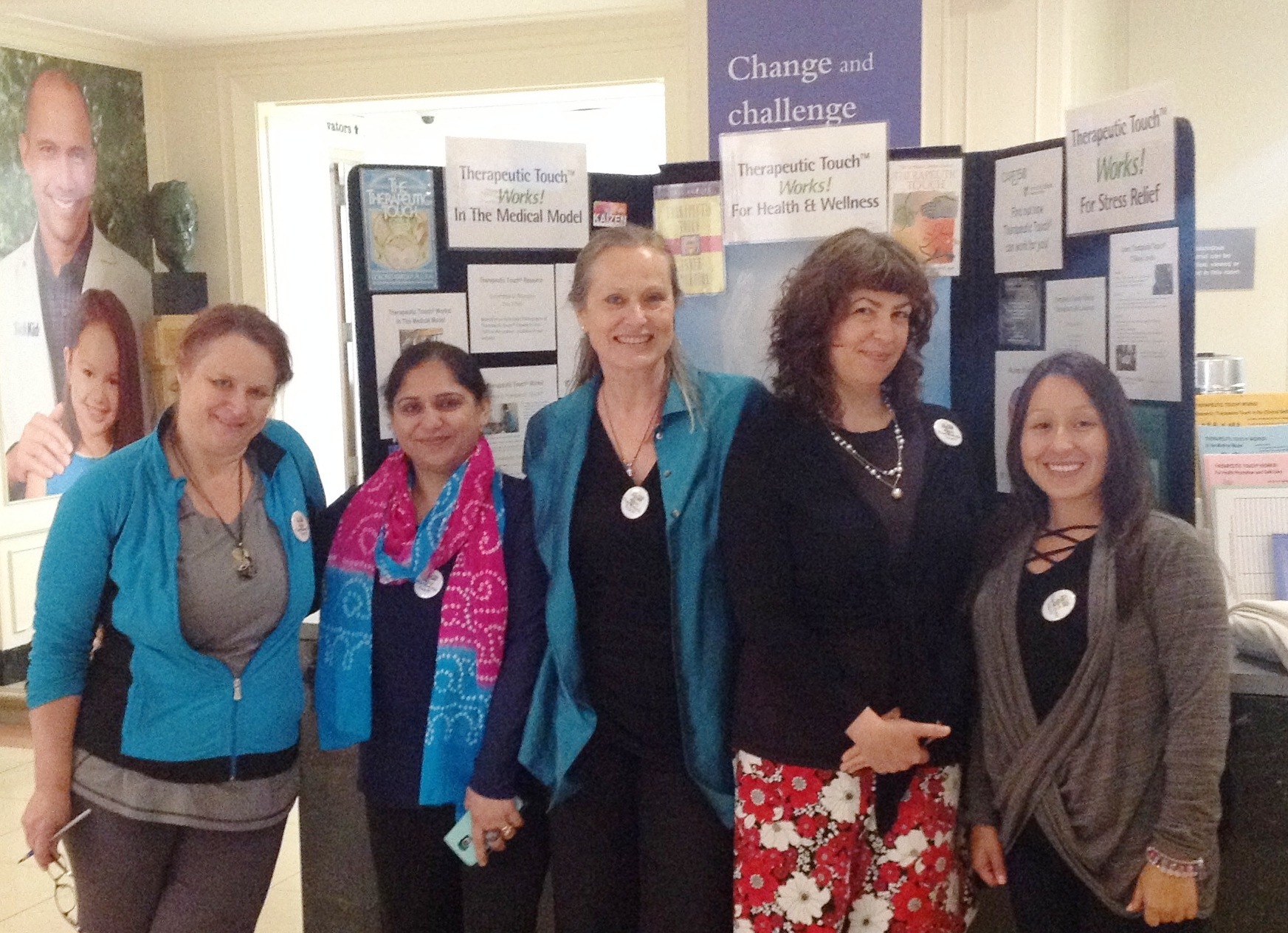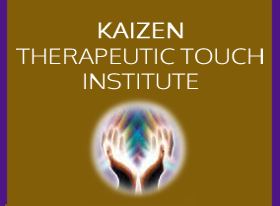
Therapeutic Touch Practitioners (5 of the team of 12) (From L to R: Cherry Wilken, Dolly Ahluwalia, Julia von Flotow, Heidi Pospisil and Maria Tello)
The Therapeutic Touch Network of Ontario’s annual CARE150 Therapeutic Touch Awareness Week May 7 – 13, 2018, provided an opportunity to conduct a modest research project on respondents’ experience of their Therapeutic Touch® sessions.
Therapeutic Touch (TT), an evidence-based, complementary, biofield therapy affects body, mind, emotions and spirit in a gentle healing way. Dolores Krieger, RN, PhD, inspired by her nursing students who wanted “some thing more they could do for their palliative patients”, developed Therapeutic Touch with Dora Kunz, her mentor, natural healer and medical intuitive, in the early 1970s.
Method:
Field research was conducted through 14 Therapeutic Touch outreach events conducted May 7 – June 27, 2018, hosted by 5 hospitals, 6 long term care centres, 2 hospices and 1 convent in the GTA, (Mississauga, Etobicoke and Toronto area).
A team of 12 Therapeutic Touch practitioners (teachers and students with various levels of training and experience) conducted a total of 209 Therapeutic Touch mini sessions offered primarily to staff at the 14 events. The team ranged from 1 to 7 practitioners at each event with the average team size of 3 TT practitioners.
The Therapeutic Touch mini-session consisted of an introduction, explanation of Therapeutic Touch with permission requested for gentle touch or non-contact TT. Sessions were conducted in chairs and were 12 – 15 minutes long. While an ideal 20 minute rest period following the session to allow the benefits of the session to be integrated was suggested during the introduction, the rest period for each session varied in length from just a few minutes to a few people who had a deep rest of at least 15 minutes.
Results
Following the rest, session recipients responded to a brief feedback questionnaire. Tabulated results are as follows:
| Total # Sessions | 209 | |
| # New To TT | 147 | 70% |
| Session Rated Excellent | 162 | 78% |
| Session Rated Good | 39 | 19% |
| Session Rated OK | 4 | 2% |
| Average self-assessed rate of qualitative improvement | 3.6 | 36% |
| Highest self-assessed rate of qualitative improvement* | 9 | |
| Interest in learning more about TT | 147 | 70% |
An important finding from this study was that the recipient’s session ranking (excellent, good, ok or poor) was not correlated to the practitioners’ level of training or experience.
While the average self-assessed rate of qualitative improvement reported by session recipients was 3.6 out of 10 or 36% improvement; 5.5% of the respondents reported a 90% rate of improvement (1 poor to 10 tops)!
Therapeutic Touch session recipients were asked to identify which aspects of their being – physical, emotional, mental or spiritual, were helped: 23% of respondents reported being helped on all 4 domains of their being: physical, emotional, mental and spiritual. While 12% reported being helped physically and mentally and 10% reported being helped emotionally. The remaining 55% identified feeling helped in a variety of combinations of the 4 domains of being.
When comparing data gathered from respondents in 6 Long Term Care homes with that from 5 Hospitals 70% in each were new to TT; the average self-assessed qualitative improvement was assessed at 4.1 out of 10 or 41% by staff in Long Term Care compared to 3.3 or 33% by staff in Hospital settings. The highest self assessed rate of improvement was 9 out of 10 or 90% by staff in Long Term Care agencies and 8 out of 10 or 80% by hospital staff.
34% of respondents in hospital settings reported that the Therapeutic Touch session helped them in all 4 domains of their being physically, emotionally, mentally and spiritually compared with 16% of respondents in Long Term Care settings.
Some Respondent Comments
“My energy recharged.”
“I felt welcomed, relaxed, at ease, peaceful and energized all at once” was common feedback received
“Feeling totally relaxed. Really I feel totally relaxed both physically and mentally.”
“I was feeling my shoulders, like a heavy weight have been lifted; feel in great spirits now.”
“Before the session I was depressed and in my painful “picture” of eternity that stretched on and on; During the session, the depression lessened and I thought about eternity. I “saw” so much going on. I wouldn’t see the end of eternity and I smiled!!! I wasn’t sure I wanted to come to the session but now I am fascinated. Thank you!”
“I went from feeling extremely tired & cold at the start of the session to energized and warm.”
Many thanks to our community partners for hosting Therapeutic Touch in-service presentations and Therapeutic Touch sessions for staff healing and wellness: Sick Kids Hospital, Harold and Grace Baker Centre, St. George Care Community, Heart House Hospice, Queensway Health Centre Oncology Clinic, Dorothy Ley Hospice, Main Street Terrace LTC, Trillium Health Partners – Mississauga Hospital, Credit Valley Hospital, John Paul II Care Center of Copernicus Lodge, Extendicare Bayview and St. Clair O’Connor Community Inc.
The Practitioner’s Perspective
For the practitioner, Therapeutic Touch is a learning journey on a healing path; the Therapeutic Touch session, a mindfulness practice in action, guided by compassionate intent to facilitate healing – helping the client restore balance, wholeness and flow in their energy field.
Students of Therapeutic Touch commit to practice. Achieving Therapeutic Touch Recognized Practitioner status requires dedication, commitment and self-discipline and requires basic level training in Therapeutic Touch (32 hours) 75 case studies (50 unsupervised, 15 supervised and 10 receiving) and an additional 32 hours of continuing education training. The practice of Therapeutic Touch develops sensitivity, awareness and the ability to sustain a centered state of consciousness for the duration of the session.
Insights shared by participating Therapeutic Touch practitioners:
About the clients:
- Staff on oncology wards are exceptionally burned out and needy for self-care.
- Clients wanted to participate even in a very busy work environment.
- What I noticed in the people I treated in hospital, hospice or long term care centre was that their fields were either depleted or overwhelmed.
About themselves:
- I loved working on different spectrum of people who are interested and took the time to be touched by Therapeutic Touch.
- I enjoy ‘giving back’ to caregivers and to make connections with fellow TTers and the community.
- Conducting multiple sessions deepens my practice, it allows me to connect easily and stay focused longer
- I learned that the client’s healing is my healing. Moreover, that TT is the path for me.
- My take away is that I need to offer Therapeutic Touch more often to those around me; it brings me such calm.
Many thanks to Therapeutic Touch students and colleagues who participated in this research project: Cherry Wilken, Dolly Ahluwalia, Julia von Flotow, Heidi Pospisil, Maria Tello, Dana Purghart, Maria Rossiter-Thornton, Michael Georgie, Lynne Calnek, Laura Watts, Monica Maurin and Catherine Perdue.
Conclusion and Reflection
Self assessed improvements of 36% – 90% after a 15 minute Therapeutic Touch mini-session within the context of a busy workplace validates the claim that Therapeutic Touch Works! for healing and wellness.
Whether Therapeutic Touch sessions offered on a regular basis in a fast-paced workplace setting could have a positive impact on staff performance, satisfaction, mental health and retention requires more research conducted over an extended period of time.
How best to structure such a program? Would a ½ day Therapeutic Touch clinic, with 30 minute relaxation sessions offered on a bi-weekly basis in the workplace help mitigate staff burnout, stress and compassion fatigue?
Would having staff in healthcare facilities trained in Therapeutic Touch, give them the means to help themselves while healing others by applying mindfulness practice in action that they learn?
How many staff trained in and practicing Therapeutic Touch in their departments would it take to transform the workplace culture into one of healing and wellness?
More research is required to answer these questions and others that emerge in the practice. We look forward to collaborating with our community partners and others to find the answers to these questions and work together to build a culture of healing and wellness.






Congratulations for doing this research and making a positive difference in healthcare .